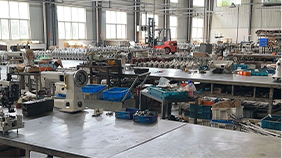leather sewing machine for beginners
A Beginner's Guide to Choosing a Leather Sewing Machine
Sewing leather can be an incredibly rewarding hobby, allowing you to create everything from bags and wallets to clothing and home decor. However, if you’re just starting out, choosing the right sewing machine is crucial to your success. In this article, we’ll explore what to look for in a leather sewing machine for beginners, along with some helpful tips and techniques to get you started.
Understanding Leather Types
Before diving into the details of sewing machines, it's important to understand the types of leather you'll be working with. Leather comes in various forms, including
- Full-grain leather The highest quality, made from the outer layer of the hide. Retains natural grain and is very durable. - Top-grain leather Similar to full-grain but sanded and treated for a smoother finish. - Genuine leather Made from leftover scraps and is typically less durable. - Synthetic leather Made from plastic, it's often more affordable and easier to work with for beginners.
Understanding these differences will help you choose the right type of leather for your projects and the most suitable machine.
Features to Look for in a Leather Sewing Machine
As a beginner, not all sewing machines will suit your leather sewing needs. Here are some features you should consider when selecting a leather sewing machine
1. Heavy-Duty Capability Leather is significantly thicker than regular fabric, so look for machines labeled as 'heavy-duty' or 'industrial.' These machines will have stronger motors and more robust construction to handle thicker materials.
2. Walking Foot A walking foot is essential for sewing leather as it helps move the material evenly through the machine. This feature prevents slipping and ensures an even stitch, which is crucial for professional results.
3. Leather Needles Ensure the machine is compatible with leather needles, which have a sharp point designed specifically for piercing through tough materials without causing damage.
4. Adjustable Tension The ability to adjust tension is critical when working with leather. Different types of leather and thicknesses may require different tension settings to achieve the best results.
5. Speed Control Having a machine with adjustable speed control is beneficial for beginners. Slower speeds allow for more precise sewing, especially in tight corners or intricate designs.
6. Durable Bobbin Case A sturdy bobbin case is essential, as leather can sometimes cause regular bobbin cases to jam or break. Look for machines that come with a solid bobbin system.
leather sewing machine for beginners

Recommended Leather Sewing Machines for Beginners
While there are many machines on the market, here are a few beginner-friendly options known for their leather sewing capabilities
- Singer Heavy Duty 4423 This machine is a popular choice for beginners due to its affordable price and robust features. It has a strong motor and various stitch options, making it versatile for both leather and fabric projects.
- Brother ST371HD Brother's heavy-duty model is designed with sewing leather in mind. It includes a walking foot and offers a wide range of stitches.
- Juki TL-2010Q Ideal for those who are serious about sewing, this machine features a powerful motor and an industrial design. It’s excellent for both quilting and leather work.
Getting Started with Leather Sewing
Once you have your machine, here are some tips to help you start sewing leather
- Practice on Scraps Begin with scrap pieces of leather to practice stitching and get comfortable with the machine's settings.
- Use the Right Foot Invest in a walking foot or a Teflon foot that helps glide over leather.
- Don’t Rush Take your time to ensure precision. Confidence will grow with practice.
- Finish Edges Use techniques like edge sealing or burnishing to finish off your projects to achieve a professional look.
Conclusion
Choosing the right leather sewing machine as a beginner is essential for creating beautiful and durable leather projects. By understanding the features you need, selecting the right materials, and practicing your techniques, you can embark on a rewarding journey in leather crafting. With patience and creativity, you'll soon find yourself sewing unique pieces that you can cherish or share with others. Happy sewing!
-
Boost Production Efficiency with a Pattern Sewing MachineNewsAug.29,2025
-
Industrial Excellence with the Best Heavy Duty Sewing MachineNewsAug.29,2025
-
Precision and Power with the Best Pattern Sewing MachineNewsAug.29,2025
-
Reliable Bulk Packaging Starts With the Right FIBC Sewing MachineNewsAug.29,2025
-
Advanced Packaging Solutions: Elevate Productivity with Jumbo Bag Sewing Machine and Industrial Stitching EquipmentNewsAug.29,2025
-
High-Performance Solutions for Bulk Packaging: FIBC Sewing Machine and MoreNewsAug.29,2025
-
Maximize Efficiency with an Industrial Cylinder Arm Sewing MachineNewsAug.28,2025


























